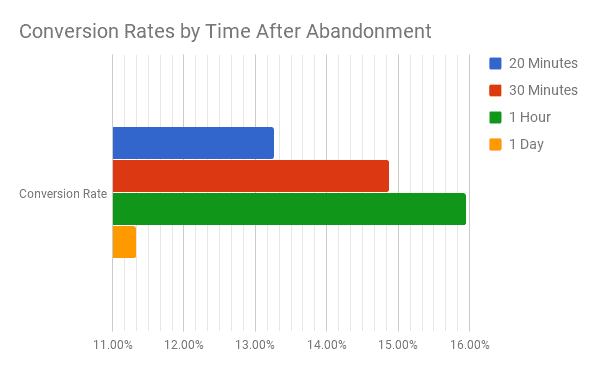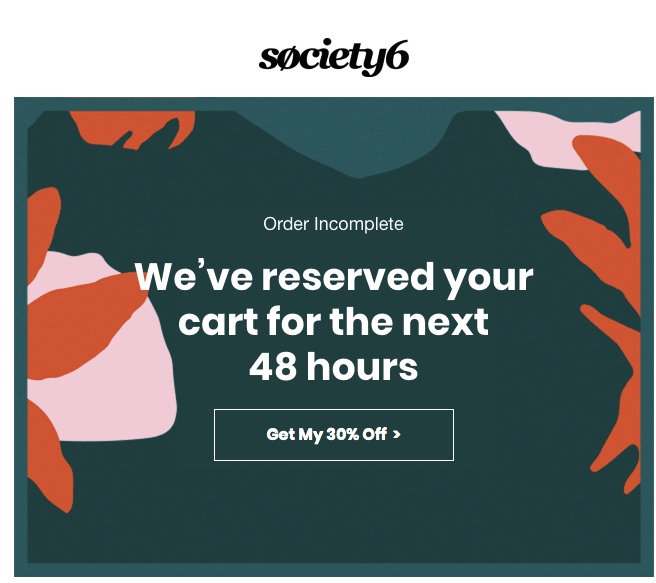Abandoned cart emails automatically get sent out when someone adds a product to their online cart, then leaves the page before finalizing the checkout process. This type of email sequence is great for reminding potential customers to come back and complete their purchases.
Research shows that almost 70% of consumers abandon their carts—but abandoned cart email sequences can generate a click-through rate of 23.33%, meaning nearly a quarter of those will click back to their cart while considering whether to complete the purchase.
However, to see good success rates with your cart abandonment emails, you need to know how to create the best email sequence you can. We’ve got eight abandoned cart email best practices to help you get started.
Want to increase sales from cart abandoners? Keep these eight best practices in mind when creating your next email sequence.
1. Start your abandoned cart email sequence within 24 hours
Don’t wait too long before starting your abandoned cart email sequence. You still want the product(s) your customer almost purchased to be top of mind.
While you absolutely must send that first email within 24 hours of cart abandonment, studies show that the optimal time is actually one hour after abandonment, according to Rejoiner.

2. Send out three emails
Many businesses simply send out a single cart abandonment email and call it a day. If the customer comes back, great. If not, we tried.
However, best practices dictate that your abandoned cart email sequence should consist of three emails for optimal results. One study done by Klaviyo analyzed nearly 10 million cart abandonment emails to find some of the best data, and here are the results.
Sequences of three emails generate the best results at $24.9 million in revenue. That’s 6.5x the revenue that a single abandoned cart email sends. Two emails generate the second-best results at $16.4 million, then four emails, before we get to the revenue that just one email brings.
This tells us that your abandoned cart emails can’t be a one-and-done. And if they are, you could be leaving a ton of revenue on the table.
But what should go into those three emails? You don’t want to just send the same email three times. One good rule of thumb is to break your emails down like this:
- Email #1: A brief reminder of their abandoned cart
- Email #2: A suggestion that they finalize their purchase
- Email #3: An incentive (like a discount code or free shipping)
3. Use a catchy subject line
Make your emails stand out in your recipient’s inbox. Use a subject line that’s going to grab attention and get your customer to open it.
Klaviyo’s study found that simply reminding your customer about their abandoned cart generates a 47.67% open rate. Their data found that the average cart abandonment open rate was around 41.18%, meaning a simple reminder (one popular subject line is, “It looks like you left something behind”) increased opens by 6.5%.
However, we encourage you to experiment with your subject line, too. Add some of your brand’s personality to it.
For example, this subject from BarkBox adorably mentions that the customer’s dog wanted a reminder sent about their toys.
Brainstorm ideas for your own subject lines that will make your customers want to open your emails.
4. Write engaging email copy
If your subject lines should be catchy, then your email copy should be even more attention-grabbing and enticing. Throw some personality in there and get your customer to want to shop with your brand.
Here’s a fun example from Adidas:

“Is your Wi-Fi okay?” in big, bold letters helps lighten the mood and assume that it was just a little mistake, the customer wouldn’t have chosen not to fulfill their purchase!
Think about how you can create email copy that helps increase the chances that your recipient clicks through and decides to finish up a purchase.
5. Share high-quality product imagery
Your emails should be simple, but not boring. And they should absolutely include high-quality photos of the product(s) they’ve left behind.
Your photos will likely be automatically pulled from your product page—so step one is to ensure high-quality product photography is used there. Second, make sure your imagery shows up nice and large in your emails so it’s part of the main focus.
Here’s a great example from Jack Wills:

The product information—and photos—are front and center.
If you’re unable to include photos that large, consider taking a page from this Food52 example:

While they’ve included the product left behind lower in the email, they also have a visually appealing header photo with a large assortment of their products to help make the email more attractive.
6. Include a call-to-action (CTA)
The purpose of a cart abandonment email is to get your customer to take action in finishing their purchase. So make it clear what action you want them to take with a call-to-action button.
Here’s one example from Rudy’s Barbershop:

They’ve included a big “Checkout Now” button right underneath the products to clearly state what they’re hoping the customer will do.
CTA button options include:
- Shop Now
- Checkout Now
- Take Another Look
- Complete My Order
- Return To My Items
- View My Cart
- Continue Shopping
7. Create a sense of urgency
Urgency can help customers decide to make purchases more quickly. One case study found that creating urgency with their customers increased sales by an astronomical 332%. And it can help you make a sale with your cart abandonment emails.
Here’s an example of what this might look like from Society 6:

Letting customers know their cart is only available for a certain amount of time can increase the odds they take action much more quickly.
Other ways to create a sense of urgency with your abandoned cart emails include:
- Letting customers know when products are selling out
- Sharing that the cart will expire soon
- Including information about limited-time-only products
- Using phrases like “Don’t wait too long,” or “Going, going, gone!”
8. Provide an incentive
Finally, include some sort of incentive like a discount or free shipping that will help your customer feel better about spending money and making a purchase.
Here’s an example from Winc of what that might look like:

They’re offering a $20 off discount code to those who go back and complete their purchase—with fun CTAs like “Let’s do this” and “I’m ready for wine.”
Providing some additional incentive—whether it’s free shipping, money savings, or even a free product—can be a great way to get customers through the door, especially after they’ve abandoned their carts.
Use these abandoned cart email best practices in your next sequence
The bottom line is that abandoned cart emails work. Keep your customers from abandoning your course and digital products with these best practices. Learn more about creating abandoned cart email sequences with Teachable.
Join more than 150,000 creators who use Teachable to make a real impact and earn a real income.



%201%20(1)%20(1).png)

.png)
.png)


